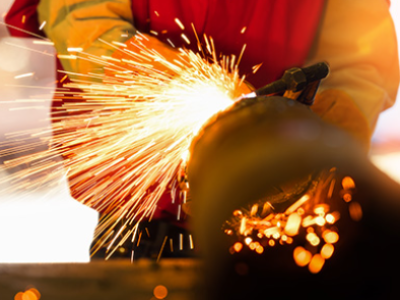Difference Between Acetylene and Propane
What is the Difference Between Acetylene and Propane Cutting, Which Cut is More Advantageous?
Acetylene and propane gases, which are frequently preferred in cutting, welding, and annealing works together with oxygen as flammable gas, have different advantages and disadvantages when compared to each other. In both of them, it is important to use the right equipment in order to get healthy results in terms of quality, cost, and efficiency.
Before scrutinizing acetylene and propane gases in comparison with their results such as quality, cost, performance, it is necessary to briefly provide information about questions such as what acetylene gas is, what propane gas is, what is it for, what are the areas of use.
Although acetylene (C₂H₂) is a triple bond carrying hydrocarbon, it is not toxic but acts as an asphyxiant at high concentrations. It is a very flammable and combustible gas. It is used in cutting and welding works. Acetylene is passed through hot copper pipes and a substance called benzene is obtained. Benzene is used as a raw material in the production of many organic substances. It is also widely used in the production of plastics in the chemical industry.
Propane (C3H8) is a colorless gas composed of carbon and hydrogen. It is used as a flammable gas in welding and cutting works as in acetylene gas. Liquid petroleum gas (LPG) contains lots of propane. In industry and our daily life, it is also used as a fuel in forklifts and many buses, as a tube in homes, in kitchens, and in generators to provide electricity.
Cutting process
When the flame temperatures are compared, we see that the oxy-acetylene flame reaches higher temperature values than the oxy-propane flame.
Oxy-Acetylene:3100°C
Oxy-Propane: 2800°C
Nevertheless, when the two mixture gases are examined as heating value, the fact that the heating value of the flame formed by oxy-propane gas is higher attracts attention.
Oxy-Propane: 95,758 KJ/m³
Oxy-Acetylene: 54,772 KJ/m³
The higher flame temperature of oxy-acetylene is not sufficient for it to be preferred over oxy-propane alone. The high focused heat release capacity of oxy-acetylene gas allows it to cut holes faster. Cutting thin sheets can be made more practically with oxy-acetylene.
Higher heating value of propane gas provides an advantage in cutting thick-sectioned parts. The area under the influence of heat is narrower than the cutting process with oxy-acetylene. The fact that the flame focus is lower than the acetylene gas reduces the risk of wearing off the edges by melting during cutting. Edge cutting quality is higher than oxy-acetylene. Oxy-propane gas is often preferred particularly in shipyards where thick-section parts are used.
Welding Process
Oxy-propane is not preferred much in oxy-gas welding. The structure of the oxy-acetylene flame allows welding to be performed by cleaning the surface of the material to be welded and creating a suitable shielding gas. Oxy-propane gas can be used in a soldering process. However, the use of oxy-acetylene gas generally gives better quality results in a soldering process.
Annealing Process
While acetylene gas creates a hotter flame, the fact that the propane gas creates a flame at a higher temperature as a result of its high calorific value, and the use of oxy-propane is preferred as it increases the annealing efficiency.
Acetylene and Propane Cost Differences
The amount of oxygen needed by propane gas to react with oxygen gas to form a flame is higher than that of acetylene. While 1 liter of acetylene gas can react with approximately 1 liter of oxygen gas, 1 liter of propane gas reacts with approximately 4 liters of oxygen gas and creates a flame. Hence, the oxygen gas consumption is about 4 times higher when propane is used.
The cost of propane gas is lower than acetylene gas. As the usage cost of which gas is more advantageous may vary depending on the place and purpose of use, the practical calculation of gas consumption in the production processes will give the most accurate result. However, the use of oxy-propane gas generally brings along lower costs.
Safety
Since acetylene gas is an unstable and unbalanced gas, it is suitable for being separated into its components. Therefore, when it is compressed with a pressure of more than 2.5 atmospheres in the free state and its temperature increases, the carbon and hydrogen in its composition start to decompose. At the same time, it explodes by increasing its pressure 11 times without ignition and combustion. As a result, pressures higher than 1.5 atmospheres are not permitted in acetylene production devices.
The result of this situation should not be perceived to mean that propane gas is a safer gas than acetylene. While acetylene gas is lighter than air, as a result of the fact that propane gas's specific gravity is heavier than air, any propane leak in a confined space can precipitate onto the floor and cause poisoning. If propane gas does not receive enough oxygen while reacting with oxygen gas, incomplete combustion may occur, giving carbon monoxide to the environment and posing a risk of poisoning.
Both gases become flammable and explosive as a result of their compounds with air and oxygen at certain rates. Flame check valves must be used for work safety.
In both methods of cutting acetylene and propane, it is important to use the right equipment to obtain healthy results in terms of quality, cost, and efficiency. To examine our products in detail, you can review the Gekamac Gas Fixtures product page.
